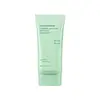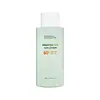What's inside
What's inside
 Key Ingredients
Key Ingredients

 Benefits
Benefits

 Concerns
Concerns

 Ingredients Side-by-side
Ingredients Side-by-side

Water
Skin ConditioningEthylhexyl Salicylate
UV AbsorberHomosalate
Skin ConditioningButyloctyl Salicylate
Skin ConditioningDibutyl Adipate
EmollientNiacinamide
SmoothingBis-Ethylhexyloxyphenol Methoxyphenyl Triazine
Skin ConditioningPropanediol
Solvent2,3-Butanediol
HumectantMethylene Bis-Benzotriazolyl Tetramethylbutylphenol
UV FilterMethyl Trimethicone
Skin ConditioningPolysilicone-15
UV FilterButylene Glycol
HumectantDiethylamino Hydroxybenzoyl Hexyl Benzoate
UV Filter1,2-Hexanediol
Skin ConditioningMethyl Methacrylate Crosspolymer
Pentylene Glycol
Skin ConditioningCamellia Sinensis Leaf Extract
AntimicrobialCentella Asiatica Extract
CleansingHouttuynia Cordata Extract
Skin ConditioningAloe Ferox Leaf Extract
Skin ConditioningCamellia Sinensis Leaf Water
MaskingOlea Europaea Fruit Oil
MaskingSodium Hyaluronate
HumectantArgania Spinosa Kernel Oil
EmollientHydrogenated Lecithin
EmulsifyingArtemisia Vulgaris Oil
PerfumingRosmarinus Officinalis Leaf Oil
MaskingJuniperus Communis Fruit Oil
MaskingFerula Galbaniflua Resin Oil
AntimicrobialBehenyl Alcohol
EmollientPolyglyceryl-3 Methylglucose Distearate
EmulsifyingPoly C10-30 Alkyl Acrylate
Emulsion StabilisingGlycerin
HumectantTromethamine
BufferingDecyl Glucoside
CleansingCarbomer
Emulsion StabilisingAcrylates/C10-30 Alkyl Acrylate Crosspolymer
Emulsion StabilisingSodium Stearoyl Glutamate
CleansingPolyacrylate Crosspolymer-6
Emulsion StabilisingEthylhexylglycerin
Skin ConditioningDimethicone
EmollientSqualane
EmollientAdenosine
Skin ConditioningHydrogenated Polyisobutene
EmollientSodium Polyacrylate
AbsorbentIsononyl Isononanoate
EmollientPolyglyceryl-10 Stearate
Skin ConditioningPropylene Glycol
HumectantCetearyl Alcohol
EmollientStearic Acid
CleansingButyrospermum Parkii Butter
Skin ConditioningPolyglyceryl-2 Dipolyhydroxystearate
Skin ConditioningXanthan Gum
EmulsifyingPolyether-1
Inulin Lauryl Carbamate
Emulsion StabilisingDisodium Stearoyl Glutamate
CleansingTocopherol
AntioxidantHydrolyzed Hyaluronic Acid
HumectantSodium Acetylated Hyaluronate
HumectantWater, Ethylhexyl Salicylate, Homosalate, Butyloctyl Salicylate, Dibutyl Adipate, Niacinamide, Bis-Ethylhexyloxyphenol Methoxyphenyl Triazine, Propanediol, 2,3-Butanediol, Methylene Bis-Benzotriazolyl Tetramethylbutylphenol, Methyl Trimethicone, Polysilicone-15, Butylene Glycol, Diethylamino Hydroxybenzoyl Hexyl Benzoate, 1,2-Hexanediol, Methyl Methacrylate Crosspolymer, Pentylene Glycol, Camellia Sinensis Leaf Extract, Centella Asiatica Extract, Houttuynia Cordata Extract, Aloe Ferox Leaf Extract, Camellia Sinensis Leaf Water, Olea Europaea Fruit Oil, Sodium Hyaluronate, Argania Spinosa Kernel Oil, Hydrogenated Lecithin, Artemisia Vulgaris Oil, Rosmarinus Officinalis Leaf Oil, Juniperus Communis Fruit Oil, Ferula Galbaniflua Resin Oil, Behenyl Alcohol, Polyglyceryl-3 Methylglucose Distearate, Poly C10-30 Alkyl Acrylate, Glycerin, Tromethamine, Decyl Glucoside, Carbomer, Acrylates/C10-30 Alkyl Acrylate Crosspolymer, Sodium Stearoyl Glutamate, Polyacrylate Crosspolymer-6, Ethylhexylglycerin, Dimethicone, Squalane, Adenosine, Hydrogenated Polyisobutene, Sodium Polyacrylate, Isononyl Isononanoate, Polyglyceryl-10 Stearate, Propylene Glycol, Cetearyl Alcohol, Stearic Acid, Butyrospermum Parkii Butter, Polyglyceryl-2 Dipolyhydroxystearate, Xanthan Gum, Polyether-1, Inulin Lauryl Carbamate, Disodium Stearoyl Glutamate, Tocopherol, Hydrolyzed Hyaluronic Acid, Sodium Acetylated Hyaluronate
Water
Skin ConditioningZinc Oxide
Cosmetic ColorantCyclohexasiloxane
EmollientButyloctyl Salicylate
Skin ConditioningPropanediol
SolventPropylheptyl Caprylate
EmollientDicaprylyl Carbonate
EmollientIsododecane
EmollientPolyglyceryl-3 Polydimethylsiloxyethyl Dimethicone
Skin ConditioningCaprylyl Methicone
Skin ConditioningMethyl Methacrylate Crosspolymer
Centella Asiatica Leaf Extract
Skin ConditioningCentella Asiatica Extract
CleansingCamellia Sinensis Leaf Extract
AntimicrobialMentha Aquatica Extract
TonicMadecassoside
AntioxidantCitrus Aurantium Bergamia Fruit Oil
MaskingCitrus Aurantium Dulcis Oil
MaskingLavandula Angustifolia Oil
MaskingSodium Hyaluronate
HumectantCitrus Nobilis Peel Oil
MaskingLitsea Cubeba Fruit Oil
MaskingDisteardimonium Hectorite
StabilisingMagnesium Sulfate
Triethoxycaprylylsilane
1,2-Hexanediol
Skin ConditioningPolyglyceryl-2 Dipolyhydroxystearate
Skin ConditioningPolymethylsilsesquioxane
Lauryl Polyglyceryl-3 Polydimethylsiloxyethyl Dimethicone
Skin ConditioningGlyceryl Caprylate
EmollientCaprylyl Glycol
EmollientEthylhexylglycerin
Skin ConditioningButylene Glycol
HumectantTocopherol
AntioxidantLimonene
PerfumingLinalool
PerfumingCitral
PerfumingWater, Zinc Oxide, Cyclohexasiloxane, Butyloctyl Salicylate, Propanediol, Propylheptyl Caprylate, Dicaprylyl Carbonate, Isododecane, Polyglyceryl-3 Polydimethylsiloxyethyl Dimethicone, Caprylyl Methicone, Methyl Methacrylate Crosspolymer, Centella Asiatica Leaf Extract, Centella Asiatica Extract, Camellia Sinensis Leaf Extract, Mentha Aquatica Extract, Madecassoside, Citrus Aurantium Bergamia Fruit Oil, Citrus Aurantium Dulcis Oil, Lavandula Angustifolia Oil, Sodium Hyaluronate, Citrus Nobilis Peel Oil, Litsea Cubeba Fruit Oil, Disteardimonium Hectorite, Magnesium Sulfate, Triethoxycaprylylsilane, 1,2-Hexanediol, Polyglyceryl-2 Dipolyhydroxystearate, Polymethylsilsesquioxane, Lauryl Polyglyceryl-3 Polydimethylsiloxyethyl Dimethicone, Glyceryl Caprylate, Caprylyl Glycol, Ethylhexylglycerin, Butylene Glycol, Tocopherol, Limonene, Linalool, Citral
 Reviews
Reviews

Ingredients Explained
These ingredients are found in both products.
Ingredients higher up in an ingredient list are typically present in a larger amount.
1,2-Hexanediol is a synthetic liquid and another multi-functional powerhouse.
It is a:
- Humectant, drawing moisture into the skin
- Emollient, helping to soften skin
- Solvent, dispersing and stabilizing formulas
- Preservative booster, enhancing the antimicrobial activity of other preservatives
Butylene Glycol (or BG) is used within cosmetic products for a few different reasons:
Overall, Butylene Glycol is a safe and well-rounded ingredient that works well with other ingredients.
Though this ingredient works well with most skin types, some people with sensitive skin may experience a reaction such as allergic rashes, closed comedones, or itchiness.
Learn more about Butylene GlycolButyloctyl Salicylate is a chemical UV filter structurally similar to octisalate. It is a photostabilizer, SPF booster, emollient and solvent. This ingredient helps evenly spread out ingredients.
According to a manufacturer, it is suitable for pairing with micro Titanium Dioxide, Zinc Oxide, and pigments.
Photostabilizers help stabilize UV-filters and prevents them from degrading quickly.
Learn more about Butyloctyl SalicylateCamellia Sinensis Leaf Extract is derived from the leaves of the tea plant. Black tea, green tea, and oolong tea are all harvested from this plant.
This ingredient has many skin benefits:
This ingredient contains polyphenols, a strong antioxidant. Antioxidants help fight off molecules that damage skin cells.
On top of that, the antioxidants in green tea neutralize free-radicals from the sun. This gives the skin some extra UV protection, but should not replace sunscreen.
Many components of tea have anti-inflammatory properties.
Polyphenols and L-theanine help soothe the skin and reduce irritation. The caffeine in Camellia Sinensis Leaf Extract helps calm inflamed blood vessels.
Other compounds found in tea include: Vitamin Bs, linoleic acid, magnesium, calcium, iron, and zinc.
Research has shown both drinking Camellia Sinensis Leaf Tea and applying it to the skin can help boost skin elasticity and hydration. Studies also show using tea extract may reduce sebum, or oil, production.
Learn more about Camellia Sinensis Leaf ExtractCentella Asiatica Extract (Centella) is derived from an herb native to Southeast Asia. It is famous for its anti-inflammatory and soothing properties.
Centella is rich in antioxidants and amino acids, such as Madecassic Acid and Asiaticoside.
Studies show the compounds in centella help with:
The combination of all these properties makes centella effective at soothing, hydrating, and protecting the skin.
Other great components of centella include Vitamin A, vitamin C, several B vitamins, and Asiatic Acid.
Fun fact: Centella has been used as a medicine and in food for many centuries. As a medicine, it is used to treat burns, scratches, and wounds.
Learn more about Centella Asiatica ExtractEthylhexylglycerin (we can't pronounce this either) is commonly used as a preservative and skin softener. It is derived from glyceryl.
You might see Ethylhexylglycerin often paired with other preservatives such as phenoxyethanol. Ethylhexylglycerin has been found to increase the effectiveness of these other preservatives.
This ingredient comes as a powder made up of small, porous, microbeads. It is used to add a silky feel to products and also helps absorb oil.
Polyglyceryl-2 Dipolyhydroxystearate isn't fungal acne safe.
Propanediol is an all-star ingredient. It softens, hydrates, and smooths the skin.
It’s often used to:
Propanediol is not likely to cause sensitivity and considered safe to use. It is derived from corn or petroleum with a clear color and no scent.
Learn more about PropanediolSodium Hyaluronate is hyaluronic acid's salt form. It is commonly derived from the sodium salt of hyaluronic acid.
Like hyaluronic acid, it is great at holding water and acts as a humectant. This makes it a great skin hydrating ingredient.
Sodium Hyaluronate is naturally occurring in our bodies and is mostly found in eye fluid and joints.
These are some other common types of Hyaluronic Acid:
Learn more about Sodium HyaluronateTocopherol (also known as Vitamin E) is a common antioxidant used to help protect the skin from free-radicals and strengthen the skin barrier. It's also fat soluble - this means our skin is great at absorbing it.
Vitamin E also helps keep your natural skin lipids healthy. Your lipid skin barrier naturally consists of lipids, ceramides, and fatty acids. Vitamin E offers extra protection for your skin’s lipid barrier, keeping your skin healthy and nourished.
Another benefit is a bit of UV protection. Vitamin E helps reduce the damage caused by UVB rays. (It should not replace your sunscreen). Combining it with Vitamin C can decrease sunburned cells and hyperpigmentation after UV exposure.
You might have noticed Vitamin E + C often paired together. This is because it is great at stabilizing Vitamin C. Using the two together helps increase the effectiveness of both ingredients.
There are often claims that Vitamin E can reduce/prevent scarring, but these claims haven't been confirmed by scientific research.
Learn more about TocopherolWater. It's the most common cosmetic ingredient of all. You'll usually see it at the top of ingredient lists, meaning that it makes up the largest part of the product.
So why is it so popular? Water most often acts as a solvent - this means that it helps dissolve other ingredients into the formulation.
You'll also recognize water as that liquid we all need to stay alive. If you see this, drink a glass of water. Stay hydrated!
Learn more about Water